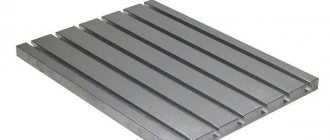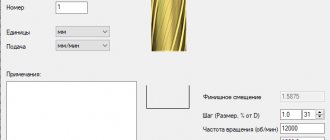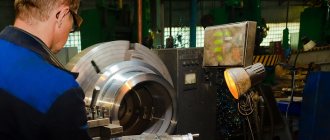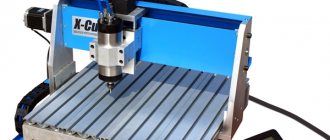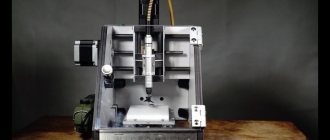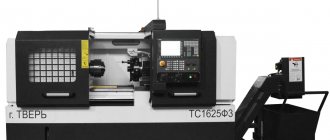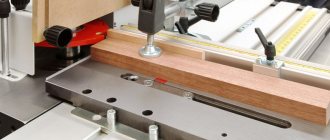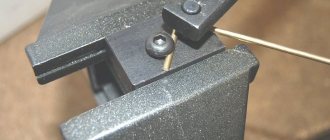Cylindrical cutters
Horizontal milling equipment uses cylindrical cutters with straight and helical teeth. Accordingly, carbide cutting edge plates will have the same appearance. Straight cutters are used for machining narrow surfaces. The screw teeth have a smooth stroke, which provides more accurate processing parameters.
Cylindrical cutter
If it is necessary to process a part with a tool inclination angle that creates maximum pressure on the axis, in order not to damage the part, twin cutters with counter-directed teeth are used. This allows you to evenly distribute the load on the axle. During the cutting process with a double cutter, the cutting edge of one element is overlapped by the edge of the counter element. Thanks to this, there is no hint on the finished part that it was processed not with a single tool, but with a composite tool.
End mills
End ones are used for processing parts that need to be given a complex relief with convexities, smooth streamlined transitions from one element to another and concave surface lines. End mills are produced with cylindrical and conical shanks.
End mills
An end mill is used to form deep grooves, shoulders and contour recesses on the body of parts. The main cutting tools of this group of tools are the edges of the teeth located on the cylinder. In this type of work, auxiliary end guards serve to protect the bottom of the groove. The cutter diameter chosen is 1/10 mm less than the required groove width.
Cutting tools are used for milling machines in manual and semi-automatic control modes, equipped with a CNC system and milling and copying equipment. The tapered shank provides greater rigidity of the spindle attachment. Thanks to this, the creation of a complex outline of an object is carried out in compliance with the error inherent in the design of the machines on which this cutting tool is used.
End mill production video
Externally, the end ones resemble a large-diameter drill. But only a small portion of end mills have a cutting element on the bottom of the head. The main processing edges are located on the edges of the tool spirally twisted around the axis.
Application
- processing of the end or side outer plane;
- creating a shaped contour of a part from a rectangular or flat workpiece;
- boring holes created with another metal tool to the required size.
Metal milling: methods and types
The movement of the cutting tool relative to the part can be achieved due to the translational movement of the rotating cutter itself or the gradual feeding of the workpiece - this depends on the design of the machine. Depending on the thickness of the cut layer, the characteristics of the metal and the desired surface quality, milling the workpiece can be carried out in one or several passes. These same factors influence the determination of the optimal feed rate.
Regardless of the characteristics of the metal and the type of machine for milling the part, the cutting speed V and the feed speed of the part S are determined. Both parameters have the dimension m/min. The cutting speed V is calculated by the formula V=π*D*n, where π is the Pi number (3.14), n is the rotation speed of the cutter, D is its diameter.
Milling methods
There are two ways to process parts on milling machines:
- counter;
- passing.
In the first case, the direction of movement of the workpiece coincides with the direction of movement of the cutter. In the second, the cutter moves towards the fed workpiece. The difference between them lies in the quality of the resulting surface. If workpieces are milled using a downhill method, the machined surface is smoother. Counter milling produces a less smooth surface, so it is used in cases where it is necessary to remove a large layer of metal. As a rule, this is done during rough milling - if a second pass is planned to achieve the final (finishing) result.
Types of milling parts
Processing a workpiece on milling machines involves performing one of four types of milling or sequential use of several types.
- End milling: used for machining manholes, windows, pockets, splines, grooves, etc. In this case, milling processing is carried out using slot, disk, end, T-shaped, single- and double-angle cutters.
- End milling is used for processing large surfaces. Milling of such parts is carried out using end or cylindrical cutters.
- Shape milling is necessary when working with profiles. To obtain shaped surfaces with the desired geometry, shaped, modular, disk and hob cutters are used.
- Metal cutting (milling of material for the purpose of cutting it) can be performed with cutting cutters, which are like a circular saw.
In metal recycling, reverse classification is also used, the principle of which is to combine cutters according to technological characteristics into groups, each of which is intended for a specific type of processing of parts.
Angle cutters
Corner is necessary to create an angular groove and the edge of an inclined or beveled plane. On single-angle cutters, the cutting blades are located vertically, along the conical body and at its end. 2-corner ones are distinguished by the location of 2 cutting edges on interacting adjacent bodies. Most often, these cutters are used in the production of milling tools.
Angle cutters
The small corner one belongs to the end group; it is equipped with a shank. The thickness of its cut is uneven - the minimum value is at the axis of rotation, the maximum value along the diameter of the created circle is at the cutting tip of the tooth. Changes in the cutting angle are reflected in uneven heating of the tool, which quickly disables it. Thinning the teeth one at a time will reduce the heat. To extend service life, it is advisable to round the top of the teeth.
Cut-off cutters
Unlike end cutting, cutting is used for processing only in a straight line. Disc cutters are used to separate the completed part from the overall piece of material. If necessary, disc cutting machines can be used to cut grooves and grooves; they can also make a through cut on a universal milling machine or equipped with CNC. Disc machines are designed for machining cast iron and medium-hard steel.
Cut-off cutters
Methods for increasing wear resistance
High performance characteristics are guaranteed by high-quality heat treatment of the equipment. The cutter can be subjected to various hardening options, which increase their wear resistance. Hardening is performed using the following methods:
- Light. This is a type of thermal step processing. To implement this, it is necessary to cool the steel with special compounds. Basically, a mixture of molten alkali and water is used for these purposes.
- Intermittent. This technology is popular because it eliminates the risk of cracks appearing in finished products.
- Continuous. This type of hardening is rarely used, since it is performed with accelerated cooling. And such manipulations often cause cracks to appear on the device.
- Stepped. This type of hardening involves cooling the workpieces in a hot atmosphere (up to 600 degrees), and then in the open air.
- Very rarely, isothermal partial or complete hardening, as well as induction heating, can be used.
During heat treatment, heating is carried out:
- In special salt baths.
- In gas and electric units in a protective environment.
- High frequency currents.
Milling cutters are necessary for processing metal products and cutting grooves and other holes in them, which is why choose it correctly. Consider all the nuances of the subsequent processing process and the type of metal you are going to work with.
Face milling cutters
In accordance with GOST, end milling cutters are manufactured in two types - with small and large teeth. A diameter of 40-50 mm assumes that it is mounted on a longitudinal key. Tools 63-100 mm in diameter are mounted on an end key. End attachments can be right-handed or left-handed. If necessary, coarse cutters can have an uneven distribution around the circumference of the cutting elements. During manufacturing, the choice of the direction of the teeth, responsible for the side in which cutting will be carried out, is selected in accordance with production needs, the processing feature of a particular type of part and the design feature of milling machines.
End mills
Round and pentagonal face mills can use mechanically held inserts. Fine-toothed ones are equipped with insert knives with tips made of carbide plates. End mills are used for processing flat workpieces on vertical milling machines. Their profiling edges are only the tips of the teeth, the end cutting edges perform auxiliary work, the main cutting function falls on the side elements.
Nuances of equipment selection
Choosing the right tool for yourself is not difficult; you just need to know the characteristics and parameters of the equipment. Such parameters include the number of teeth and the material from which the product is made. The key to choosing a product material is the strength of the metal you are going to cut.
Required number of teeth
The processing speed and cleanliness of the cut depend on the number of teeth the tool has . The greater their number, the cleaner the cutting area will be. But at the same time, the load on the electric motor greatly increases, and the process of removing chips from the cutting site worsens. And because of these reasons, the speed of penetration into the thickness of the metal and rotation of the tool decreases. If the number of teeth is small, then the size of the sinuses between them increases. These factors speed up cutting and facilitate removal of chips. But there will be grooves at the ends, which should be additionally cleaned.
Cutting cutters with a negative angle and overall diameter have more teeth. A device with a positive angle and a small diameter will have a smaller number of teeth.
A small number of teeth ranges from 10-40, an average - 40-80, and a large - 80-90. It is the samples with an average number of teeth that are suitable for various types of cutting. It is these samples that are most effective for working on materials of different hardness.
For finishing milling, cutting disc tools with small teeth are used, and for primary milling, with large teeth. Discs designed for roughing work are characterized by unhindered and quick removal of excess chips from deep cutting areas.
How to choose material
For cutting metals with a strength of 500 to 800 MPa, cutters made of high-speed steel with the addition of molybdenum, the amount of which is approximately 5%, are used. To work with metals whose strength exceeds 800 MPa, choose tools with a cobalt content of up to 5%. To work with precious metals, high-precision cutters are made from high-speed steel of the best quality.
For processing stainless steel, disc tools with tungsten carbide tips are used. These teeth are not ground, they are coated with a PVD layer.
Shaping cutters
To process parts with curved, complex contours, shaped disc cutters are used. They are used for a narrow range of work and can be:
- semicircular convex;
- semicircular concave;
- radius.
Their peculiarity is that the cutting teeth are not located along the circle, but only on a separate part of it.
Shaping cutter
With a large variation in external diameters, the size of the internal mounting hole remains unchanged - d = 22 mm.
The group of shaped ones is divided into 2 types - with backed and sharp teeth. Both types are used for processing parts with a disproportionate length to width ratio. The difference in processing is that the backed one has a zero outer angle and a positive back angle. It is more convenient for sharpening and does not require additional equipment, but its processing cannot be called finishing. A sharp-toothed tool provides cleaner, more precise processing. But to keep it in proper working condition, you will need a copier for sharpening.
It also has its own scope of application and prefabricated shaped tools. Its individual cutting edges with a simple shape form a complex curve. A cutter of a similar design is used for processing railway wheelsets, as well as other complex monolithic metal forms. 2 adjacent slats with attached carbide plates are mounted in the grooves of the housing.
Spline cutters
Spline or worm are used for cutting teeth on the shaft or gear of a gear transmission or spline connection along a side profile. Spline cutters are a whole group of tools with a different arrangement of teeth around the circumference of the disk or only on a cylindrical surface. They also differ in the method of fastening the cutting elements.
Spline cutter
Disc cutters
The most convenient for cutting deep grooves of different widths are three-sided disk ones. A tool equipped with adjustable plates is more often used as a groove tool. The feature of changing the angle of the cutting elements allows you to cut a groove or groove.
Disc cutter
Disc grooves are designed to create shallow grooves. Their teeth are located on a cylindrical body. An angle widening towards the outside helps reduce friction when cutting grooves or grooves. The peculiarity of this cutter is that it is narrower at the hub than in outer diameter.
2 and 3 sided have teeth on the end sides. Their lateral cutting edges are auxiliary, the main ones are located on the cylinder itself. Teeth located around a circle can have positive and negative angle inclination values. Negative corners at the end are cut off.
Scope of application
The number of operations performed using a cutter is extremely large. Which explains their high demand.
- Rough processing of metals and non-metals - cutting, cutting, drilling, roughing.
- Drilling grooves of various shapes - grooves, grooves, screw channels, cavities of helical wheels, and so on.
- Processing corners and edges.
- Finishing and cutting , manufacturing of parts of complex geometric shapes: stamps, blades, molds.
- Artistic milling - with the help of cutters, complex elegant elements are turned out of wood, 3D images and ornaments are formed on a plane.

